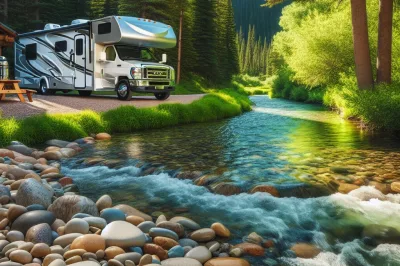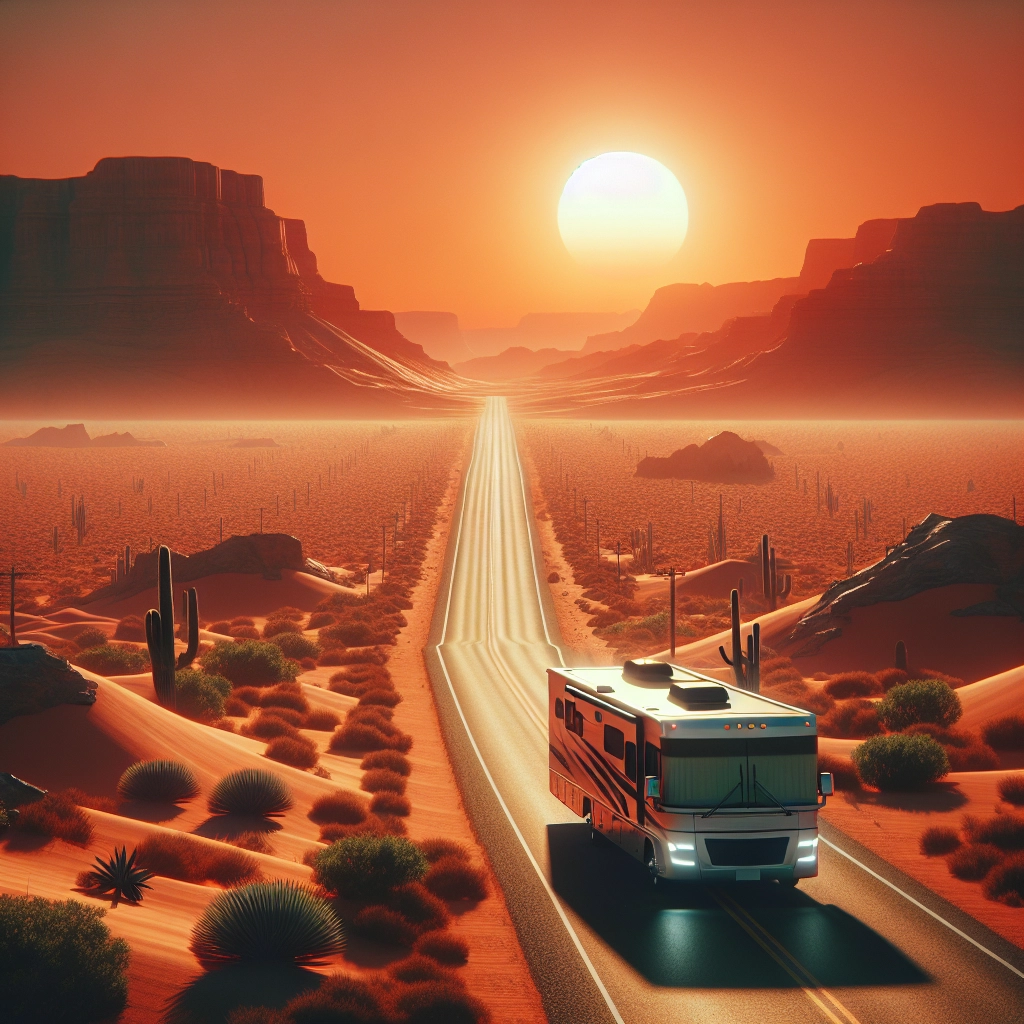Table of Contents

Harness the Sun: Your Guide to Solar Power for Off-Grid Living
Imagine the freedom of traveling in your RV, surrounded by nature, without the need to plug into the grid for power. Solar energy is your ticket to this kind of independence. It’s clean, it’s quiet, and once set up, it’s free energy from the sun. Whether you’re parked in a lush forest or a desert landscape, solar power can sustain your RV’s energy needs and reduce your carbon footprint.
Understanding the Basics of RV Solar Systems
Solar power systems for RVs are not just a trend; they’re a lifestyle change. At its core, an RV solar system converts sunlight into electricity that you can use to power your appliances and devices. This process involves solar panels, a charge controller, batteries, and an inverter. Each component plays a crucial role in ensuring you have a reliable power supply. And the best part? You’re harnessing energy from the sun, which means no fuel costs and minimal maintenance.
Key Components of a Solar Setup for Boondocking
Let’s break down the solar setup into digestible bites. First up, solar panels capture the sun’s rays. The charge controller manages the power flow, protecting your batteries from overcharging. Batteries store this power, giving you energy when the sun isn’t shining. Finally, the inverter converts the stored DC power into AC power, which most of your RV appliances use. It’s a harmonious system that keeps the lights on and your coffee hot.
- Solar Panels: Your personal power plant, soaking up the sun’s energy.
- Charge Controller: The vigilant guardian, keeping your batteries safe and sound.
- Batteries: The energy vault, storing power for when you need it.
- Inverter: The translator, turning DC power into usable AC power for your gadgets.
With these components, you can create an efficient and self-sufficient power system for your RV. Whether you’re a weekend warrior or a full-time nomad, solar power offers the freedom to explore without boundaries.
Mastering Energy Consumption for Long-Term Sustainability
Adopting solar power is just one piece of the puzzle. To truly embrace off-grid living, you need to become a master of your energy consumption. It’s about understanding how much power you use and making smart choices to extend your energy reserves. This isn’t just about saving power; it’s about ensuring a sustainable, comfortable lifestyle on the road.
Smart Energy-Saving Habits for Full-Time RVers
Energy-saving habits are the secret sauce to maximizing your solar power system. Simple actions like turning off lights when not in use, using natural light during the day, and unplugging devices when they’re fully charged can make a significant difference. It’s all about being mindful of your energy use and making small adjustments that add up to big savings.
Gadgets and Appliances: Choosing Energy-Efficient Options
When it comes to gadgets and appliances, the name of the game is efficiency. Energy-efficient appliances consume less power, which means your solar system can support more of your lifestyle. Look for devices with a high Energy Star rating—they’re designed to give you the performance you need without the energy drain.
By focusing on energy efficiency and smart habits, you can make the most of your solar setup and enjoy the freedom of off-grid living. With these tips, you’re well on your way to a sustainable, eco-friendly RV lifestyle that doesn’t compromise on comfort or convenience.

Maximizing Battery Life: Strategies for Storage and Management
Think of your RV’s battery as the heart of your solar power system. Just like a heart, it needs proper care to keep pumping energy efficiently. Maximizing battery life isn’t just about saving money; it’s about ensuring you have power when you need it most. Proper storage and management practices can extend the life of your batteries, meaning less waste and more time adventuring off-grid.
Types of Batteries for Solar Applications
When it comes to batteries for solar applications, you’ve got options. Lead-acid batteries have been the go-to for years, being cost-effective and widely available. However, lithium-ion batteries are the new kids on the block, offering longer lifespans and better performance, albeit at a higher price point. AGM (Absorbent Glass Mat) batteries are another solid choice, known for their durability and low maintenance.
- Lead-Acid Batteries: Affordable and reliable, with more frequent maintenance.
- Lithium-Ion Batteries: Higher upfront cost, but longer lifespan and efficiency.
- AGM Batteries: Spill-proof and sturdy, with less need for upkeep.
Choosing the right type of battery for your needs will depend on your budget, how often you use your RV, and how much maintenance you’re willing to do. Each type has its pros and cons, so consider what’s most important for your lifestyle on the road.
Optimizing Charge Cycles to Prolong Battery Health
To keep your batteries in top shape, you’ll want to optimize their charge cycles. This means not letting them discharge too deeply and not overcharging them. Use a quality charge controller to manage this balance and protect your batteries from the wear and tear of improper charging. By keeping an eye on your charge levels and treating your batteries right, they’ll serve you well for years to come.
Remember, the key to longevity is regular monitoring and maintenance. With a proactive approach, you can avoid the pitfalls that shorten battery life and stay powered up for all your off-grid adventures.
Getting the Most Out of Your Solar Panels
Solar panels are your personal power plants, but to get the most out of them, they need a little attention. It’s not just about having panels; it’s about optimizing their performance. This means placing them correctly, keeping them clean, and performing regular maintenance. When your panels are at their best, they’ll generate more power, which means more freedom for you on the road.
Proper Solar Panel Placement and Angling
Proper placement and angling of your solar panels can significantly increase their efficiency. You want to capture as much sunlight as possible, which means positioning your panels where they’ll get direct sun exposure for the majority of the day. Adjust the angle of your panels with the seasons—higher in the winter and lower in the summer—to align with the sun’s position. A little adjustment can lead to a big boost in power production.
It’s also smart to park your RV so that your panels are exposed to the sun while the living areas are shaded, keeping you cool and your panels hot—hot with electricity, that is.
Cleaning and Maintenance for Peak Performance
Clean solar panels are happy solar panels. Dirt, dust, and debris can block sunlight and reduce efficiency, so regular cleaning is a must. Use a soft cloth or brush and some water to gently wipe the panels clean. While you’re up there, check for any damage or wear and tear that might affect performance. Regular maintenance ensures your panels are always ready to soak up the sun and power your off-grid life.
With these strategies for battery care and solar panel optimization, you’re well-equipped to embrace the solar-powered RV lifestyle. Remember, a little effort goes a long way in maintaining your independence and sustainability on the open road.

Supplementary Renewable Solutions: Beyond Solar
Solar power is a fantastic resource for boondockers, but it’s not the only renewable energy option out there. Expanding your energy toolkit to include other renewable sources can provide additional security and efficiency. Diversifying your energy sources means you’re less likely to be caught without power when the weather doesn’t cooperate.
Wind Power Generators: A Boondocker’s Ally
Wind power generators can be an excellent complement to solar panels. They work day and night, as long as there’s a breeze. They’re particularly useful in areas where wind is more reliable than sunshine. Small, portable wind turbines are available that are suitable for RV use. They can fold up while you’re on the move and quickly set up at your next destination.
“I met a couple in Colorado who swore by their wind generator. They showed me how it kept their batteries topped off on cloudy days when their solar panels weren’t as effective. It was a real eye-opener to the benefits of a hybrid system.”
When considering wind power, think about the typical weather patterns of your favorite boondocking spots. If you often find yourself in windy locales, a wind generator could be a smart addition to your energy system.
Hybrid Systems: Integrating Multiple Renewable Sources
Hybrid systems that combine solar and wind power offer the best of both worlds. You can harness the sun’s energy during the day and the wind’s power at night or during overcast conditions. This approach can provide a more consistent power supply and reduce the need for a generator or shore power.
- Solar Panels: Capture sunlight and convert it to electricity.
- Wind Turbines: Generate power from the wind, day or night.
- Battery Bank: Store energy from both sources for use at any time.
- Charge Controller: Regulate the power going to the batteries from both the solar panels and wind turbine.
- Inverter: Convert stored DC power into AC power for your RV’s appliances.
By integrating multiple renewable sources, you can create a robust system that keeps you powered up in a variety of conditions.
Practical Installation Tips for DIY Enthusiasts
Installing a solar power system on your RV can be a rewarding DIY project. It not only saves you money on installation costs but also gives you a deeper understanding of your energy system. Let’s walk through some practical tips and a basic tool checklist to get you started on the right foot.
Tool Checklist for Installing Your Solar Power System
Before you start your installation, make sure you have the right tools on hand. Here’s a basic checklist:
- Drill and drill bits
- Screwdrivers (both flathead and Phillips)
- Wrench set
- Wire strippers and crimpers
- Wire cutters
- Voltmeter
- Caulking gun and sealant
- Safety glasses and gloves
Having these tools ready will help ensure a smooth installation process.
Step-by-Step Guide to Setting Up Your Solar Atmosphere
Now that you have your tools, let’s walk through the installation process. Here’s a simplified step-by-step guide:
- Plan Your Layout: Decide where you’ll place your solar panels and components. Consider ease of access and exposure to sunlight.
- Install Mounting Hardware: Securely attach the mounting brackets to your RV’s roof, ensuring they’re properly sealed against the elements.
- Mount the Solar Panels: Carefully place the solar panels onto the mounting hardware and secure them in place.
- Wire the Panels: Connect the solar panels to the charge controller using the appropriate gauge wire.
- Install the Charge Controller: Mount the charge controller in a convenient location, close to the batteries but in a well-ventilated area.
- Connect to the Battery Bank: Use proper cables to connect the charge controller to your battery bank.
- Set Up the Inverter: Install the inverter near the battery bank and connect it to the batteries.
- Test the System: Use a voltmeter to check connections and ensure everything is working correctly.
Following these steps will help you create a solar atmosphere that powers your RV efficiently and reliably. Remember, safety is paramount. If you’re ever unsure about a step in the installation process, don’t hesitate to consult a professional.
By taking the time to set up your solar power system correctly, you’re investing in your freedom and the sustainability of your travels. With the sun above and the open road ahead, you’re ready to embrace the boondocking lifestyle to its fullest.
Overcoming Common Challenges in Solar-Powered Boondocking
While solar power offers freedom and sustainability, it’s not without its challenges. Limited sunlight and bad weather can impact your energy harvest, and transitioning from traditional power sources requires a mindset shift. But fear not, with some ingenuity and preparation, these hurdles can be overcome, ensuring your solar-powered journey is as smooth as the open road.
Addressing Limited Sunlight and Inclement Weather
Cloudy days and unexpected weather changes can put a damper on your solar power reserves. The key is to be prepared. Start by sizing your solar system to account for less-than-ideal weather conditions. This might mean installing more panels or opting for a higher capacity battery bank. Additionally, consider having a backup power source, such as a generator, for those extended periods of overcast skies.
- Upsize your solar array to compensate for less sunny days.
- Invest in a high-capacity battery bank to store more energy.
- Keep a backup generator for prolonged inclement weather.
- Monitor weather forecasts to plan your energy usage accordingly.
By planning for the unexpected, you can ensure that your adventures don’t come to a halt when the sun decides to hide.
Navigating the Transition from Traditional Power Sources
Moving from a life plugged into the grid to one powered by the sun can be a big adjustment. Start by understanding your energy needs and how they can be met with solar power. It’s also important to educate yourself on managing and conserving energy. The transition is not just about the physical setup, but also about adopting a new way of thinking about energy use.
- Conduct an energy audit to understand your power needs.
- Learn about energy management and conservation strategies.
- Embrace a lifestyle that aligns with the capabilities of your solar system.
- Be patient and give yourself time to adjust to this new way of living.
With time, you’ll find that living on solar power becomes second nature, and the benefits far outweigh the initial learning curve.
Key Takeaways
- Solar power enables sustainable and independent RV living.
- Be prepared for weather-related challenges by upsizing your solar system and having a backup plan.
- Transitioning to solar power involves both a physical setup and a change in energy usage habits.
- Understanding your energy needs and how to meet them with solar is crucial for a smooth transition.
- Patience and education are key to adapting to a solar-powered lifestyle.
Frequently Asked Questions (FAQ)
How much solar power do I need for full-time RV living?
The amount of solar power you need for full-time RV living depends on your energy consumption, which varies based on your lifestyle and the appliances you use. A good starting point is to calculate the total wattage of all your devices and how long you use them each day. From there, you can determine the size of the solar panel array and battery bank you’ll need to meet your daily energy requirements.
As a rough estimate, an average full-time RVer might require anywhere from 300 to 800 watts of solar panels and a battery bank with a capacity of 200 to 400 amp-hours. However, it’s always best to overestimate your needs to account for inefficiencies and unexpected energy usage.
– Calculate your daily power usage in watt-hours.
– Consider the efficiency of your solar panels and batteries.
– Factor in the average sunlight hours available at your typical destinations.
– Always overestimate your needs to ensure you have enough power.
With these considerations, you can design a solar power system that keeps your RV humming along, no matter where the road takes you.
Can I run my air conditioner on solar power while boondocking?
Running an air conditioner on solar power is one of the most common questions among RVers. The short answer is yes, but it requires a substantial solar setup. Air conditioners are power-hungry appliances, so you’ll need a robust system with enough solar panels and a large battery bank to handle the high energy draw. Additionally, you’ll likely need an inverter that can handle the high surge power that air conditioners require when they start up.
– Ensure you have a large enough solar array to generate the necessary power.
– Invest in a high-capacity battery bank to run the air conditioner for extended periods.
– Use a powerful inverter that can handle the starting surge of the air conditioner.
– Consider energy-saving strategies to reduce the air conditioner’s runtime.
By planning your solar system with your air conditioning needs in mind, you can enjoy cool comfort even in the hottest locations, all while living off the grid.
What is the best type of battery for a solar RV system?
The best type of battery for a solar RV system is one that balances capacity, lifespan, and cost to fit your specific needs. Lithium-ion batteries are becoming increasingly popular due to their long lifespan, high energy density, and low maintenance. They can also be discharged more deeply than other types, making them efficient for solar applications. However, they come with a higher price tag. AGM batteries are a good middle-ground option, offering decent performance at a more affordable cost, and they’re maintenance-free. Traditional lead-acid batteries are the most economical but require regular maintenance and have a shorter lifespan.
– Lithium-ion batteries for efficiency and long lifespan.
– AGM batteries for a balance of performance and cost.
– Lead-acid batteries for the most budget-friendly option.
Consider your budget, energy needs, and willingness to perform maintenance when choosing the best battery for your solar RV system.
How do I monitor and manage my solar energy consumption?
Monitoring and managing your solar energy consumption is crucial for efficient off-grid living. The first step is to install a reliable battery monitor that provides real-time information about your system’s performance. This will help you keep track of how much energy you’re generating, using, and storing. Additionally, using energy management apps or devices can help you identify patterns in your energy usage and make adjustments to conserve power.
– Install a battery monitor to track energy production and consumption.
– Use energy management apps to analyze usage patterns.
– Regularly check your system’s performance and adjust your habits accordingly.
– Consider investing in smart devices that automatically manage energy use.
With the right tools and a bit of diligence, you can ensure that your solar system is meeting your needs and that you’re using energy as efficiently as possible.
Are there any renewable energy tax credits for RV owners?
Yes, RV owners may be eligible for renewable energy tax credits for installing solar power systems. The federal government offers a tax credit for qualified solar electric property costs. This can include solar panels, inverters, batteries, and related equipment. The credit amount has varied over the years, so it’s essential to check the current tax laws or consult with a tax professional to understand the latest incentives and how they apply to your specific situation.
In conclusion, adopting solar power for your RV is a rewarding journey towards sustainability and independence. Whether you’re cooling your space with air conditioning, selecting the best battery for your needs, keeping an eye on your energy consumption, or taking advantage of tax credits, each step brings you closer to a greener lifestyle on the open road. Embrace the sun’s power, maximize your system’s efficiency, and enjoy the boundless freedom that solar-powered boondocking has to offer. Safe travels and sunny skies to all you adventurous RVers out there!
- Boondocking RVs: Flexible Solar Solutions – 3 March 2024
- Renewable Energy Tips for Full-Time Boondocking RVers – 2 March 2024
- Boondocking Solar Power Systems: Sizing Options & Solutions for Motorhomes – 1 March 2024
